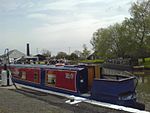Loynton Moss
Alder carrsBorough of StaffordForests and woodlands of StaffordshireGrasslands of the United KingdomKettle lakes in the United Kingdom ... and 4 more
Nature reserves in StaffordshireShropshire Union CanalSites of Special Scientific Interest in StaffordshireWetlands of England

Loynton Moss is a nature reserve of the Staffordshire Wildlife Trust, near the village of Woodseaves, in Staffordshire, England. It is adjacent to the Shropshire Union Canal, as it runs from nearby Norbury to High Offley.
Excerpt from the Wikipedia article Loynton Moss (License: CC BY-SA 3.0, Authors, Images).Loynton Moss
Pinfold Lane,
Geographical coordinates (GPS) Address External links Nearby Places Show on map
Geographical coordinates (GPS)
| Latitude | Longitude |
|---|---|
| N 52.819 ° | E -2.314 ° |
Address
Loynton Moss
Pinfold Lane
ST20 0PQ
England, United Kingdom
Open on Google Maps






